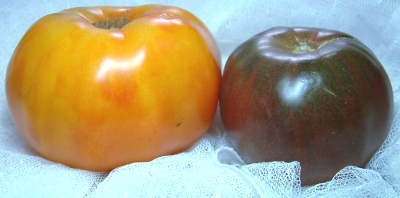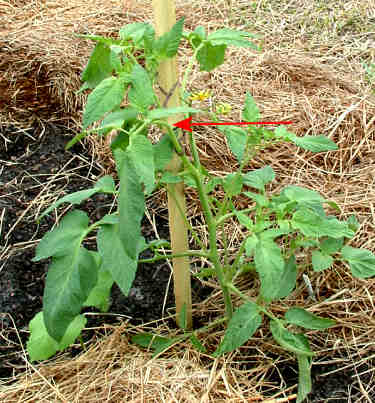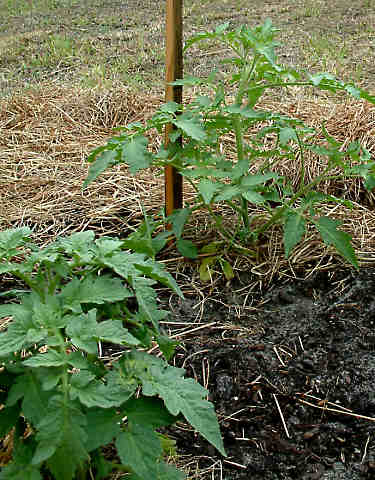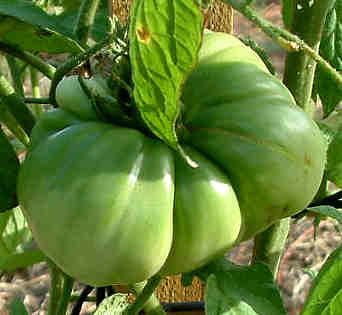growing heirloom tomatoes
Great Tomato Experiment, Revisited
I’ve had a bit of a setback on The Great Tomato Experiment; I ran into a stretch of bad weather, followed by what I think was possibly an overdose of potassium. As a result, all three plants are in sad, sad shape. In fact, so sad that I am starting over!
What Will I Do Differently?
First, is that I have come across some nice 17-gallon containers, and I’ll use them instead of the 10-gallons I had been using. I’ll sterilize and re-use the 10-gallons for some other tomatoes I have coming up for the summer (including two mystery tomatoes).
I’m going to add sphagnum peat moss and perlite to each of the containers. I’ve found the original mixture I used compacted a bit too much for my liking.
I’m going to add the main dose of fertilizer to the soil before planting, then mix it in well. I found with my raised bed tomatoes that when I did this, the plants grew more vigorously compared to the ones where I added the fertilizer as a side-dressing in the beginning.
Finally, I am using a different tomato variety. For some reason, Pineapple doesn’t seem to like my growing conditions (I have a 4th plant that I am growing in the ground in another part of the garden). It’s growing fairly well and putting forth tomatoes, but it’s not as vigorous as I would hope.
And the New Tomato Variety Is…
I have chosen Big Raspberry as the new tomato variety for The Great Tomato Experiment for the following reasons:
- Big Raspberry is a potato-leafed plant, and I find that tomato plants with potato leaves generally fare better in my garden.
- The tomatoes don’t generally get large (maybe 9 ounces), so if I can get a tomato of this variety over 1 lb using the giant tomato techniques, it will be an accomplishment.
- The plant is productive, but not necessarily tall. So if I can get the plant over 6 feet using the world record tomato techniques, it will be a visible accomplishment. Especially since I am growing it in a container!
- Finally, I’m choosing Big Raspberry because it’s an earlier tomato compared to Pineapple. Since it’s already April, I need to play catch-up before the worst of the South Florida summer heat arrives.
If you’re still wanting to experiment along with me and can’t locate Big Raspberry, a good second choice might be Prudens Purple. In fact, I would have used Pruden’s Purple as my first choice for this test if I hadn’t already had some growing in the garden. My other choice would be Caspian Pink.
So, I planted my seeds today. I planted 5 so I could choose the best 3 for the experiement. The other two…well, I’m sure I can find someone in my neighborhood who might like a couple of plants!
So, while the first part of the experiment failed, I still have an opportunity to continue. Onward!
Heirlooms in the Garden
The heirlooms in the garden are growing strong! With 2 days of gentle rain, the plants are rocketing skyward. Who said hybrids were the only ones to grow fast?
I mentioned in my post for the last heirloom tomato report that I’d post some photos. I just walked out to the garden, camera in hand, so here they are!
How Fast Have They Grown?
On this past Sunday (March 15th), I decided that I’d go around with my Sharpie permanent marker and mark how high the plants were. That way, by Sunday the 22nd, I could tell how fast they had grown.
I decided to wander out with my camera today and Brandywine has declared its intentions to make a run to the top of the 6-foor pole. See the red arrow? That’s pointing to where I marked its height on Sunday. And blossoms? The photo doesn’t show it, but there are lots and lots on the plant.
But Kellogg’s Breakfast isn’t far behind! Nor are my Pinapple tomatoes, for The Great Tomato Experiment.
Truth be told, every tomato plant is showing marked growth since Sunday. The plants that have gained the least height are my Loxahatchee plants. On the other hand, they have apparently decided that large, dark green leaves and flower buds are more important, and they are truly lovely plants.
Here’s a photo showing Loxahatchee (foreground) and Kellogg’s Breakfast (background). And speaking of Kellogg’s Breakfast, it’s also gotten a lot wider, as well as a fair amount taller.
(By the way, you can click on the photos to see a larger image.)
Black Sea Man and Druzba have grown, but not quite as spectacularly. Then again, they are both much younger plants, being in the main garden for not even 2 weeks yet. Actually, I kind of take that back — Black Sea Man has grown some huge, long leaves, and gotten quite wide. It’s just only grown an inch taller in height (which isn’t as exciting as Brandywine growing 5 inches).
The others are also doing well; White Bush is blossoming, and I can’t wait to see the ripe tomatoes on it (getting ahead of myself, though). Eva Purple Ball and Pruden’s Purple are about a week away from being transplanted into their final spots.
Oh, you may be wondering who won the blossom contest (i.e. which heirloom had the first open blossoms). The winner was…Pineapple, closely followed by White Bush. Brandywine followed and all the older plants (those that have been in the ground for at least 3 weeks) all have buds.
So that’s it for today. And if you’re womdering if I grow any hybrids, the answer is yes…and those photos are reports are coming up shortly!
Heirloom Tomato Report
I thought I’d update you with an heirloom tomato report, on how these wonderful plants are growing in the garden. I’ve had extremely unsettled weather from January through the beginning of March and the tomatoes have taken it with differing results. Here’s a homegrown heirloom tomato report!
Heirloom Tomatoes in the Garden
First, in case you aren’t aware, I am in South Florida. Although my winters have been pretty mild in the recent past, it was a cold one this year, with several freezes. Last week’s temperature dip into the 30’s didn’t help matters. But it’s warming up now, and the plants look happier.
Here’s a list of the heirloom tomatoes currently in the garden:
- Black Sea Man: Determinate, black fruit
- Brandywine: Indeterminate, pink fruit
- Druzba: Indeterminate, red fruit
- Eva Purple Ball: Indeterminate, dark pink fruit
- Kelloggs Breakfast: Indeterminate, orange fruit
- Loxahatchee: Semi-determinate, red fruit
- Mr. Stripey: Indeterminate, bicolor yellow/red fruit
- Pineapple: Indeterminate, bicolor yellow/red fruit
- Pruden’s Purple: Indeterminate, dark pink fruit
- White Bush: Determinate, white fruit
And here are the heirloom plants that (sadly) succumbed to one of the freezes:
- Big Rainbow: Indeterminate, bicolor yellow/red fruit
- Green Zebra: Indeterminate, green striped fruit
- Yellow Cherry: Indeterminate, yellow fruit
That’s not too bad, though — just three that are more temperature-sensitive.
Last Week’s Cold Snap
Almost all the plants got nipped by the dip into the 30’s last week. Green Zebra was the only casualty, but all the other plants except two showed signs of stress and/or what I call “freezer burn” on some leaves.
The two heirloom tomato varieties that came through totally unscathed were Loxahatchee and White Bush. Both acted as if the cold snap never happened. Unfortunately, White Bush doesn’t seem to be in circulation anymore (couldn’t find any seeds for sale) and Loxahatchee is from my own heirloom breeding program, and I don’t have enough seeds to offer for sale at the moment.
Heirloom Tomatoes — Who’s Blooming?
Mr. Stripey is the only one with tomatoes and blossoms, but that’s the one variety I bought as a plant; all the rest I have grown from seed.
None if the seed-grown plants are actually in full blossom at the moment, but about half have small (and in Brandywine’s case, not so small) blossom buds. So far, I expect Brandywine to have the first open blossoms, probably by Saturday.
The heirloom tomato plants that aren’t showing blossom buds, like Druzba and Pruden’s Purple, are just too young yet (I just put them in the garden a few days ago). I plant my tomatoes is waves, hoping to extend the season. While it doesn’t always work (sometimes they all stubbornly decide to ripen at the same time no matter what I do), sometimes I get lucky.
I’ll be taking some photos this weekend of the various heirloom tomato plants. I’ll also be updating The Great Tomato Experiment report. Meanwhile, you can take a look at other posts I’ve written on heirloom tomatoes.
Homegrown Tomato Shapes
Shapes for homegrown tomatoes may surprise you, if you’ve never grown them before. While some varieties may look like the unblemished round globes you see in the grocery store, many won’t look like that. On the other hand, looks can be deceiving, because even if the homegrown tomatoes don’t look as perfect, they taste soooo much better!
Tomato Shapes
First, different tomato varieties have different shapes. Some are round, some flattened. Some are smooth, others are ribbed. Not to mention there are varieties selected for their unusual shapes — sausage, pear, pleated, heart-shaped, etc.
Next, the conditions under which the tomatoes are grown can effect the fruits. For example, tomatoes that grow too fast may end up cracking. To much variation of the water level (letting them get too dry then giving them too much water) can affect the fruits, too.
Different tomato diseases can affect the fruits — anywhere from slightly “off”, all the way to the tomato is a loss.
And then there are the rogue tomatoes that just want to grow their own way, for their own reasons. 🙂
Ribs and Shoulders
As I mentioned previously, some tomatoes (especially heirlooms) just don’t grow round. They may have a lot of ribbing (pleats) around the shoulders (the end nearest to where the fruit connects to the plant).
Speaking of shoulders, they may not turn colors — sometimes the shoulders of an otherwise red or pink tomato stay green, even when ripe.
Homegrown Tomatoes May Not Be Perfect Looking…
No, your homegrown tomatoes may not look perfect, like what you see at the grocery store. But while what sells in the stores might be their looks, you can’t tell the taste until you bite into it (which isn’t appropriate in the store).
On the other hand, even if your garden-grown tomato is homely-looking, it likely tastes fabulous! And really, that’s the reason you are growing them — for the wonderful taste.
Heirloom Tomato Seeds
Heirloom tomato seeds aren’t any more difficult to plant than hybrid tomato seeds. The trick is finding the seeds you want to grow — and there is quite a variety!
 But before I talk more about the seeds, let’s talk a little about what makes an heirloom tomato an heirloom.
But before I talk more about the seeds, let’s talk a little about what makes an heirloom tomato an heirloom.
About Heirloom Tomatoes
So what exactly is an heirloom tomato — what makes it different than “regular” tomatoes?
First of all, heirlooms are produced naturally from seeds. In other words, if you save seeds from an heirloom, the resulting plants will be just like the parent. Not so with a hybrid tomato, because you’ll never know what you’ll get! This is because a hybrid is a cross between two varieties, neither of which may be great on their own (but wonderful together).
So that’s one; an heirloom produces plants like itself. The next is how long the plant has been producing tomatoes; that is, how many generations have been produced with consistent results. I’ve heard quite a few different numbers — 100 and 50 seem to be the two that pop up the most. Some people use the year 1945 as the cutoff; if the tomato variety was growing in 1945 with consistent fruit results, the plant can be considered an heirloom.
One other thing about heirloom tomatoes is their taste! In general, the heirlooms produce fruits with a full, rich tomato taste. Many of the heirloom varieties produce big fruits — beefsteak or larger. If you love tomato sandwiches, you’ll love these tomatoes.
There is one downside, though. Heirloom tomatoes are pretty strong growers, but they are not necessarily disease-resistant. So especially if you live in a hot and humid climate, you need to keep a closer eye on your heirlooms. (But it is worth it!)
Heirloom Tomato Seeds
There are tons of varieties or heirlooms out there, and I’ve tried many of them in my day. But I keep coming back to a few that are tasty, but that also have fun results! I like red tomatoes for sure, but I also get a big kick out of the purple and the striped tomatoes. That being said, here are a few of my favorite heirloom tomato varieties.
Brandywine Pink: Whenever I ask my husband what tomatoes he’d like me to grow, Brandywine always tops the list. I love the big fruits and the juicy meat of this heirloom tomato. The seeds germinate fairly quickly and transplant easily. The problem for me, though, is that it just isn’t a prolific producer of tomatoes in hot and humid climates. I get maybe one fantastic tomato (huge), a couple medium-sized and maybe one or two small ones. When it gets really hot and humid, no more tomatoes. But for taste…I don’t think I’ve had another variety beat it (yet). Brandywine Pink is an indeterminate potato-leaf plant, mid to late season. And be warned — the plants can get huge.
Cherokee Purple: This is a fun tomato because it’s purple! OK, it’s not the kind of bright purple you might be imagining; it’s more of a dusky violet. The name comes about because it’s believed to have originated among the Cherokee people, and is over 120 years old. These are big tomatoes, which seem to average between 10 and 12 ounces. Sweet and meaty, they are great for salads and sandwiches. But the purple does take a little getting used to. Thin-skinned, you will need to eat these soon after picking. Cherokee Purple is an indeterminate tomato that is mid-season.
Kellogg’s Breakfast: This is an orange beefsteak tomato. Now orange tomatoes have the reputation of being milder-tasting, but not so with Kellogg’s Breakfast — it has a full-on tomato taste! I’ve grown it in the ground and in (big) containers — grew well both ways. The tomatoes were big and the plants were surprisingly prolific for such a large beefsteak. Kellogg’s Breakfast is an indeterminate regular-leaf tomato, and the plants can get very large. There is also a Kellogg’s Breakfast version (KBX) that is potato-leaf plant, but I have never grown it. Mid-season.
Red Pear: I cannot resist these cute little tomatoes! Cherry-sized, perfect for salads or garden snacking (the fate of most of mine – few actually make it into the house). As you may guess, they are pear-shaped. Not the sweetest, but it is tasty and does tend to be prolific! The plants I have grown tended to be manageable in size, and grew well in the ground and in a container. Indeterminate, regular leaf, mid-season.
Big Rainbow: The last of the heirloom tomato seeds I’ll talk about today is one that bears monster fruits — Big Rainbow. It’s also a striped tomato color, with gold and red, so it’s very pretty to look at. Not to mention great to eat! This heirloom tomato can get fruits up to 2 pounds in size! Naturally that’s with optimum growing conditions, but 1+ pounds tomatoes can be expected on average. This tomato is also exceptional in that it’s one of the more disease-resistant of the heirlooms. (Reason enough to grow it.) Big Rainbow is an indeterminate, requires strong staking (possibly multiple stakes). It bears fruit roughly 90 days out, so only think about growing it if you have a long growing season.
So there you go; some wonderful heirloom tomato seeds for you to consider planting. For additional information on planting, check out the post on planting a tomato garden.


